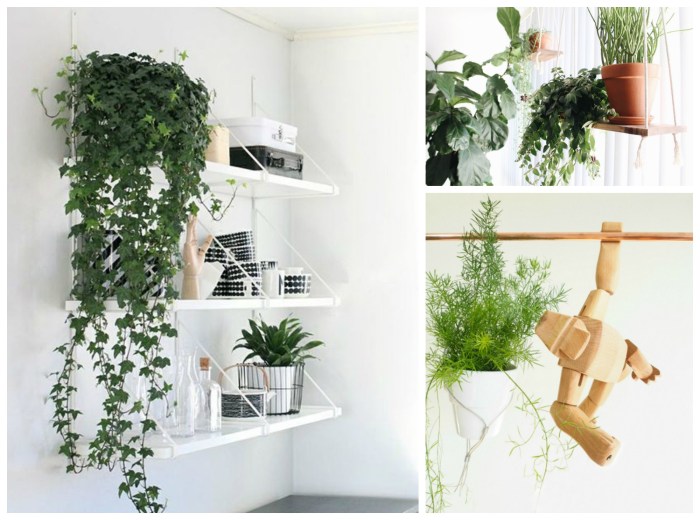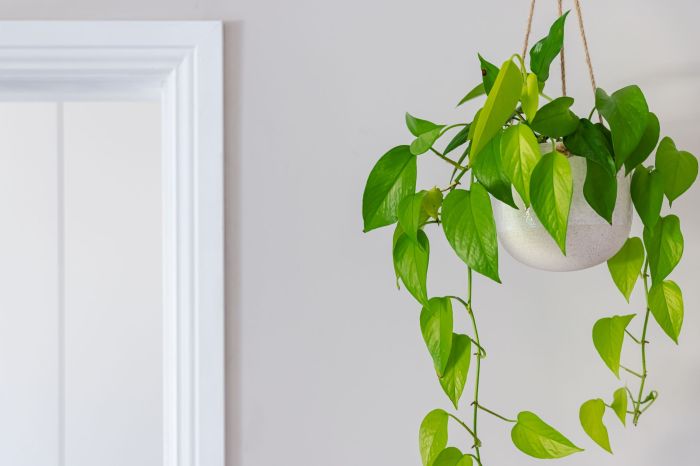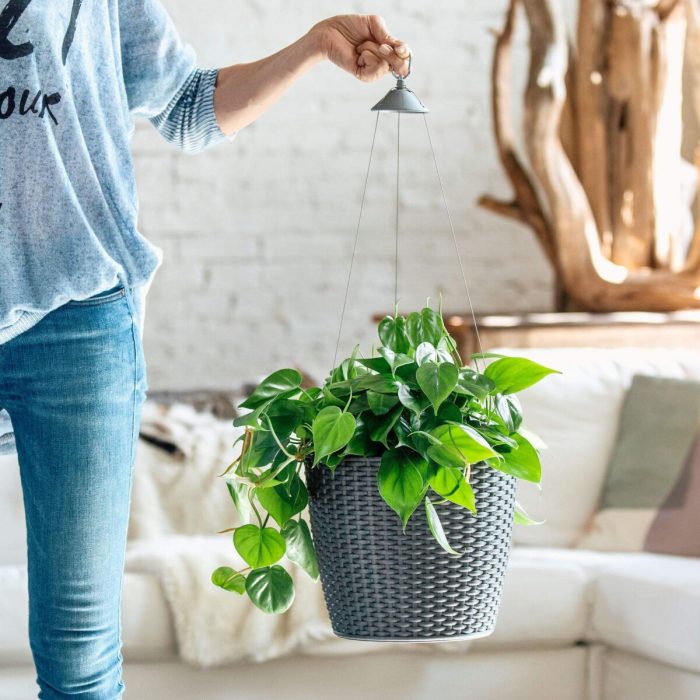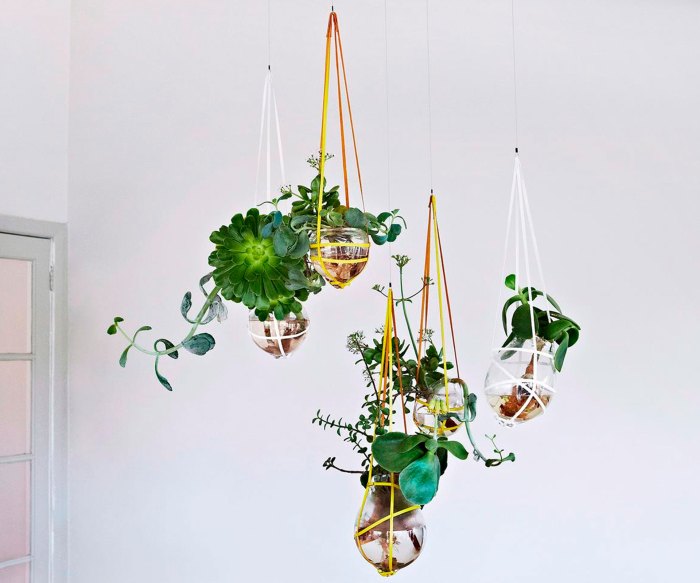Best house plants hanging introduce a new dimension to home decor, offering aesthetic appeal, air purification, and psychological benefits. From cascading ferns to trailing vines, these plants transform living spaces into lush oases, adding vertical interest and creating a sense of tranquility.
Hanging houseplants not only enhance the ambiance of a room but also provide practical advantages. Studies have shown that certain plants, such as spider plants and peace lilies, effectively remove toxins from the air, improving indoor air quality. Moreover, research suggests that indoor plants can reduce stress, boost mood, and enhance cognitive function.
Houseplants for Hanging Baskets: Best House Plants Hanging

Hanging baskets are a great way to add a touch of greenery to your home, and they can be especially useful in small spaces. There are many different types of houseplants that are suitable for hanging baskets, each with its own unique growth habits and care requirements.
When choosing houseplants for hanging baskets, it is important to consider the amount of light that the basket will receive. Some plants, such as ferns and spider plants, can tolerate low light conditions, while others, such as succulents and cacti, need more light.
It is also important to consider the watering needs of the plants. Some plants, such as African violets, need to be watered frequently, while others, such as snake plants and ZZ plants, can tolerate drought conditions.
Trailing plants are a great way to add a touch of greenery and life to your home. They’re perfect for hanging baskets, windowsills, and shelves. There are many different types of trailing plants to choose from, so you can find one that fits your style and needs.
For more inspiration on beautiful trailing plants, check out our guide to beautiful trailing plants . With so many options to choose from, you’re sure to find the perfect hanging plant to add a touch of nature to your home.
Ferns
Ferns are a classic choice for hanging baskets. They are easy to care for and can tolerate low light conditions. Some of the most popular ferns for hanging baskets include:
- Boston fern
- Maidenhair fern
- Asparagus fern
Spider Plants
Spider plants are another easy-to-care-for plant that is suitable for hanging baskets. They produce long, trailing stems with small, spider-like plantlets. Spider plants can tolerate low light conditions and do not need to be watered frequently.
Succulents and Cacti
Succulents and cacti are a good choice for hanging baskets if you want a plant that is low-maintenance and drought-tolerant. Some of the most popular succulents and cacti for hanging baskets include:
- Burro’s tail
- String of pearls
- Haworthia
African Violets
African violets are a beautiful flowering plant that can be grown in hanging baskets. They need bright, indirect light and need to be watered frequently. African violets are not drought-tolerant, so it is important to keep the soil moist.
Snake Plants and ZZ Plants
Snake plants and ZZ plants are both low-maintenance plants that are suitable for hanging baskets. They can tolerate low light conditions and do not need to be watered frequently. Snake plants and ZZ plants are both drought-tolerant, so they can withstand periods of neglect.
Benefits of Hanging Houseplants

Hanging houseplants are a popular way to add greenery and life to any room. But did you know that they also offer a number of benefits? Here are just a few of the reasons why you should consider adding some hanging plants to your home.
Aesthetic Benefits
Hanging plants can add vertical interest to a room and create a sense of lushness. They can also be used to define spaces, create privacy, and add a touch of color and life to a room.
Air-Purifying Qualities
Certain hanging plants, such as spider plants and peace lilies, have been shown to be effective at removing toxins from the air. This can help to improve air quality and create a healthier environment for you and your family.
Psychological and Emotional Benefits
Studies have shown that indoor plants can have a positive impact on our psychological and emotional well-being. They can help to reduce stress, improve mood, and boost creativity.
Designing with Hanging Plants

Incorporating hanging plants into home decor can elevate any space, adding a touch of nature and creating a sense of tranquility. When designing with hanging plants, it’s essential to consider the home decor style, plant size and shape, and hanging materials to create visually appealing and functional arrangements.
For a modern and minimalist aesthetic, opt for hanging planters with clean lines and neutral colors. Suspend a single large plant from the ceiling or group several smaller plants in staggered heights for a dynamic display.
Choosing the Right Hanging Pots and Materials, Best house plants hanging
The choice of hanging pot and materials depends on the plant’s size and shape. Larger plants require sturdy pots made from durable materials like ceramic or metal. Smaller plants can be suspended in delicate macrame hangers or woven baskets.
Consider the plant’s shape when selecting a hanging pot. Trailing plants look stunning in wide, shallow pots that allow their foliage to cascade gracefully. Upright plants, on the other hand, can be placed in taller, narrower pots.
Creating Unique and Eye-Catching Arrangements
To create unique hanging arrangements, experiment with different plant combinations and heights. Suspend a mix of trailing and upright plants from a single hanger for a lush and layered effect.
Vary the heights of hanging plants to add depth and interest. Hang larger plants at different levels or create a staggered display with smaller plants. This creates a visually dynamic effect that draws the eye.
Care and Maintenance

Hanging houseplants add a touch of greenery and elegance to any space. To keep them thriving, it’s essential to provide proper care and maintenance. This guide will cover everything you need to know, from watering and fertilizing to pruning and repotting.
Among the most popular house plants, hanging plants add a touch of elegance and freshness to any room. For those looking to bring the outdoors in, consider exploring best hanging plants for indoor spaces. With their ability to purify air, reduce stress, and add a pop of color, hanging plants are a great way to enhance your home décor and well-being.
Watering
Hanging houseplants have different watering needs depending on the species, but a general rule of thumb is to water when the top inch of soil feels dry to the touch. Avoid overwatering, as this can lead to root rot. Use lukewarm water and allow the excess to drain out of the drainage holes.
Fertilizing
Fertilize hanging houseplants every two to four weeks during the growing season with a balanced liquid fertilizer. Dilute the fertilizer to half strength to avoid burning the roots. Avoid fertilizing during the winter months when the plants are dormant.
Pruning
Regular pruning encourages bushier growth and prevents the plants from becoming leggy. Use sharp, clean shears to remove dead or damaged leaves and stems. You can also prune to shape the plants or control their size.
Repotting
Hanging houseplants should be repotted every two to three years or when they become rootbound. Choose a pot that is slightly larger than the previous one and use a well-draining potting mix. Gently loosen the roots before repotting and add fresh soil around the plant.
Hanging houseplants bring life and freshness to any room, but providing them with adequate light can be a challenge. To ensure optimal growth and lush foliage, consider using a best hanging grow light . These specialized lights emit targeted illumination, mimicking natural sunlight and promoting healthy growth in even the most dimly lit corners.
By incorporating a hanging grow light into your indoor plant care routine, you can enhance the beauty and vitality of your hanging houseplants.
Troubleshooting Common Problems
Yellowing Leaves:Yellowing leaves can be a sign of overwatering, underwatering, or nutrient deficiency. Check the soil moisture and adjust your watering schedule accordingly. If the leaves are yellowing from the bottom up, it may be a sign of nutrient deficiency. Fertilize the plant with a balanced liquid fertilizer.
Pests:Aphids, mealybugs, and spider mites are common pests that can infest hanging houseplants. Use insecticidal soap or neem oil to control the pests. Regular cleaning of the leaves can also help prevent infestations.
DIY Hanging Planters

Create unique and stylish hanging planters with these DIY projects. From repurposed items to innovative designs, these ideas will add a touch of greenery and creativity to your home.
Repurpose everyday items like old mugs, teacups, or baskets into charming hanging planters. Simply drill holes for drainage and suspend them with twine or wire.
Macrame Hangers
Macrame is a versatile technique that allows you to create intricate and beautiful hanging planters. With just a few simple knots, you can create a unique and eye-catching display for your plants.
Wooden Crates
Wooden crates can be transformed into rustic hanging planters. Simply line the crate with a plastic liner or burlap, fill it with soil, and hang it with chains or ropes.
Upcycled Light Fixtures
Old light fixtures can be given a new life as hanging planters. Remove the electrical components and create drainage holes in the bottom. Suspend the fixture with a chain or rope and fill it with plants.
Hanging Planters from Scrap Wood
Create geometric or whimsical hanging planters using scrap wood. Cut and assemble the wood into desired shapes and sizes, drill drainage holes, and suspend them with twine or wire.
Cork Board Planters
Cork boards make for unexpected and functional hanging planters. Simply cut the cork board into desired shapes, glue on a backing for support, and hang it with wire or nails.
Final Review
Incorporating hanging plants into home decor requires careful consideration of plant size, shape, and light requirements. With proper care and maintenance, these plants can thrive and bring lasting beauty and well-being to any living space. From bohemian-chic macrame hangers to modern geometric planters, there are endless possibilities for creating unique and eye-catching hanging arrangements that complement any decor style.
Q&A
What are the best house plants for hanging baskets?
Suitable plants include ferns, trailing vines like pothos and ivy, and flowering plants like begonias and fuchsias.
How often should I water hanging houseplants?
Watering frequency depends on the plant species, but generally, water when the soil feels slightly dry to the touch.
Can I use any type of hanging planter?
Choose planters with drainage holes to prevent waterlogging. Consider the weight of the plant and planter when selecting hanging materials.